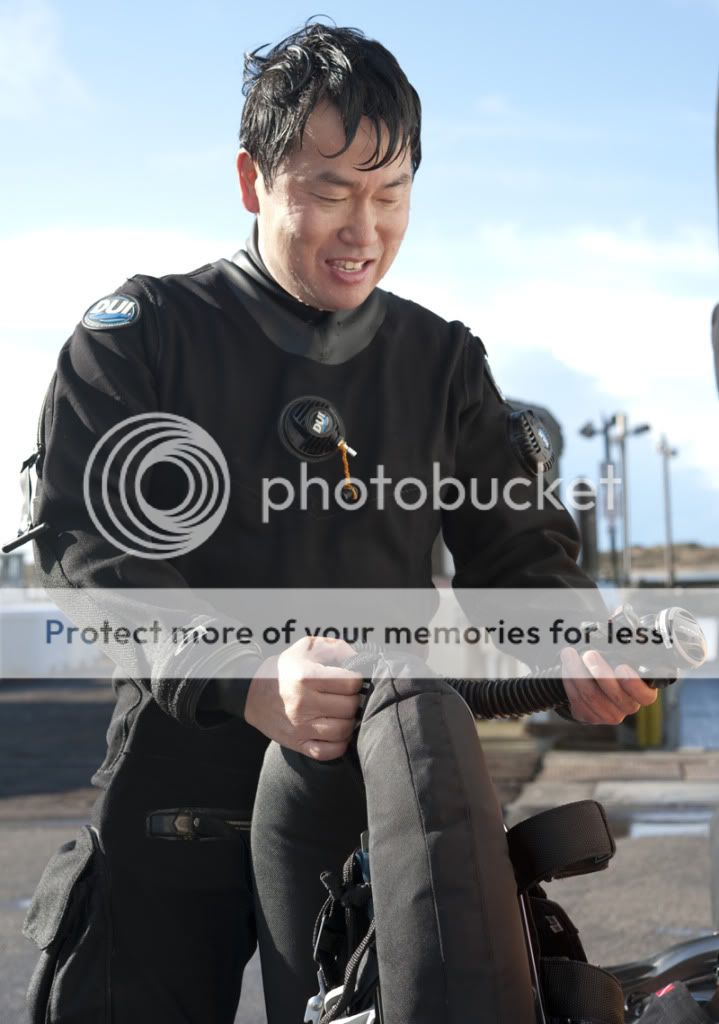|
Posted by Merry on November 08, 2011 at 13:41:10:
This was only our second trip to Morro Bay, but it already feels like home. The North T-Pier harbors an amazing array of marine life, including a seasonal parade of dozens (I think it’s fair to say) of species of nudibranch. Ken Bondy and Gary Powell have been diving, photographing, and documenting the marine life of Morro Bay for over 20 years. Their outstanding website captures the magic of the T-Pier and provides info about diving there: belowmorrobay.com Kevin Lee drove up in the middle of the night to join us for an early morning dive and get a crack at this fabled nudi site. Timing is everything here. As tide funnels through the bay, impressive, even ripping current restricts diving to a short interval at high tide. 

Each day, Kevin made 2-hour-plus dives and found a greater variety of marine species than Phil and I put together. Moreover, Phil dubbed Kevin “Nudi Master”, and he really is, finding 17 different species of nudi, 3 of which were new to him! Check out the T-shirt.

My impression is that the uncommon is common at the North T-Pier. One night, we watched commercial fisherman hauling in nets full of hagfish that they trapped at 300 fsw using pig head bait. The hagfish were bound for Korea, as live fish product.


According to Milton Love’s “Certainly More Than You Want to Know About The Fishes of the Pacific Coast. A Postmodern Experience”, this is one cool eel-like fish. They’re blind, with neither jaws nor vertebrae. That stringy goop is a mucous-like slime that hagfish produce when agitated. One set of glands produces the mucous and another set of glands produce microfilaments that transform the mucous into a more elastic substance. Why produce slime? It’s been proposed that the slime may serve to impair the gills of predator fish. Fishermen rake it out of the tanks by the handfuls.

Besides low vis, the first thing that struck me about diving under the pier was the number of bivalves. Clams everywhere, opening and closing their siphons to beat the band.
Pacific Gaper Clam.

I would not be exaggerating if I were to say that nudibranchs were as thick as flies - sometimes bumping into each other. Phil and Kevin occasionally got two uncommon-down-here species in the same frame.
Janolus barbarensis and Hermissenda crassicornis
 Acanthodoris lutea is common there.
 
Aeolidia papillosa feeds on anemones.
 
Both color variants of Polycera atra were present, some laying eggs.



Polycera hedgpethi

This approx. 5” fish was completely buried under sand before I disturbed it. Got one shot before it took off. It doesn’t appear to be a midshipman. Any ideas on the ID?

This is an invertebrate-lovers paradise. Bryozoans abound in spectacular array, both in clumps on the seafloor and on the pilings. Totally cool and intriguing amphipod species appear in nearly every bryozoan photo, but they’re too small to resolve with a 60mm lens.
The small, cryptic nudi, Adalaria jannae, blends in perfectly with its Membranipora bryozoan food source. Not only are there 3 of them in this photo, but so are their eggs. Bonanza! 

A closer look at the two Adalaria jannae. Kevin spotted these beauties.

We could spend a week diving here, but I’m not sure if that would be enough time.

| 
